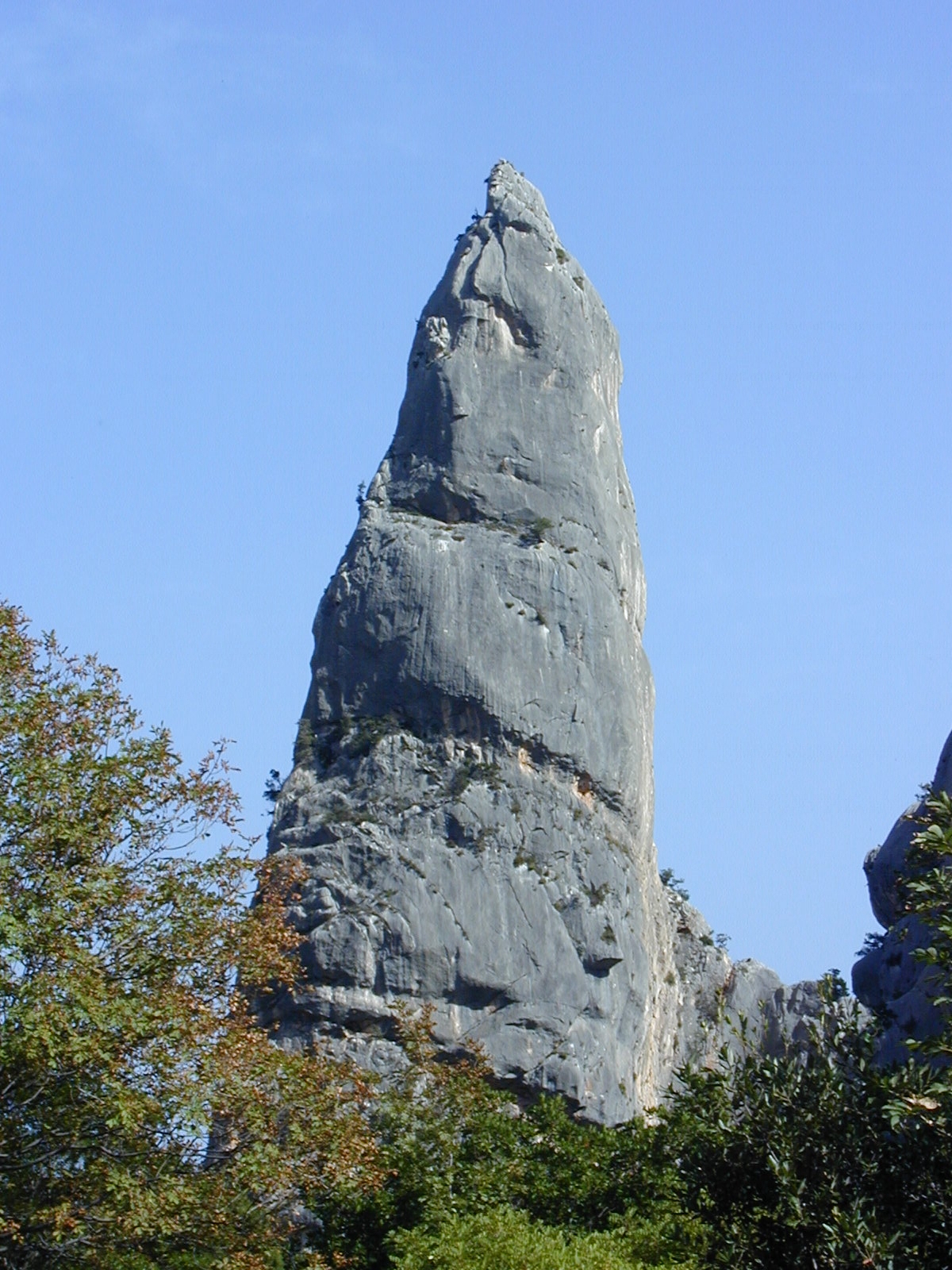zurück

Aguglia Gala Goloritze 150 m hohe grandiose Felsnadel mit dem
Beinamen aguglia a tramontana
The
Aguglia di Tramontana is a prominent and striking
rock formation located in the
Supramonte mountain range of
Sardinia, Italy. It is one of
the most famous natural landmarks in the area, drawing the attention of
climbers, hikers, and nature enthusiasts for its
dramatic appearance and
rugged beauty.
Key Features of Aguglia di Tramontana:
-
Geography and Description:
- The
Aguglia di Tramontana
is a towering limestone spire,
standing at an impressive 1,200
meters (3,937 feet) above sea level, located in the
northern part of the
Supramonte mountains.
It rises sharply from the surrounding landscape, creating a dramatic and
eye-catching silhouette.
- The rock formation is known for its
steep cliffs and
sharp, pointed shape,
which makes it one of the most distinctive landmarks in Sardinia. The
name "Aguglia" refers
to a needle or spike, which accurately describes its slender, pointed
form.
-
Climbing and Mountaineering:
- The Aguglia di Tramontana is a
popular destination
for rock climbers due
to its challenging vertical walls and impressive height. Climbers from
around the world are drawn to its
difficult routes,
which require skill and experience.
- The
climbing routes vary
in difficulty, and the summit offers
panoramic views of
the surrounding Supramonte mountains, valleys, and nearby coastlines.
The experience of reaching the top of the Aguglia is both exhilarating
and rewarding.
- For those interested in attempting
the climb, guided tours
are available, as the terrain can be difficult to navigate without
experience.
-
Hiking and Access:
- While climbing is a popular
activity for the Aguglia, there are also
hiking trails that
allow visitors to approach the base of the spire and enjoy the
surrounding landscapes. The trek to the Aguglia provides breathtaking
views of the Supramonte
region, with its rugged peaks, deep valleys, and Mediterranean
vegetation.
- The approach to the Aguglia can be
challenging, as the surrounding terrain is rocky and often requires
scrambling, but the effort is worth it for those who appreciate
Sardinia's natural beauty.
- Some hikers choose to continue
their journey by heading to nearby landmarks like
Cala Gonone or
Gennargentu, which
offer other scenic vistas and opportunities for exploration.
-
Panoramic Views:
- From the summit of the Aguglia di
Tramontana, hikers and climbers are rewarded with
spectacular views. On
a clear day, you can see the vast stretches of the
Supramonte mountains
and the Mediterranean Sea
in the distance.
- The surrounding landscape is
incredibly diverse, with towering cliffs, lush forests, and steep
ravines. The scenery is particularly breathtaking at sunrise or sunset,
when the light creates dramatic shadows on the rocky formations.
-
Wildlife and Nature:
- The Aguglia di Tramontana and its
surrounding area are home to a variety of
Sardinian wildlife.
The rugged cliffs and forests support species such as the
Sardinian wild goat,
foxes, and
wild boar, as well as
a number of bird species
like griffon vultures
and eagles.
- The surrounding forests are
composed of Mediterranean
vegetation, including
oak trees, pine trees,
and cork oaks, making
the area rich in biodiversity.
-
Cultural and Historical
Significance:
- The
Supramonte region,
where the Aguglia di Tramontana is located, has a long history of
pastoralism. The area
is known for its traditional
Sardinian villages and its cultural connection to sheep farming
and shepherding.
- Local villages like
Orgosolo and
Oliena are nearby and
offer insights into Sardinian culture, history, and craftsmanship. These
villages are often characterized by their
stone houses, narrow
streets, and traditional festivals.
-
Best Time to Visit:
- The best time to visit the Aguglia
di Tramontana for hiking or climbing is in
spring (April to
June) and autumn
(September to October). During these months, the weather is milder, and
the landscape is lush and green, especially after the spring rains.
- The
summer months can be
hot, so it’s recommended to start early in the morning to avoid the
midday heat, particularly for hikes or climbs. Winter can also be a
great time to visit, especially for those who enjoy
snow-capped mountain
views and less crowded trails.
In Summary:
The
Aguglia di Tramontana is one
of Sardinia’s most iconic and dramatic natural landmarks. Its distinctive
spike-shaped rock formation
and impressive height make it a must-see for rock climbers, hikers, and outdoor
enthusiasts. Whether you’re attempting the challenging climb, exploring the
surrounding wilderness, or simply soaking in the panoramic views from the base,
the Aguglia offers an unforgettable experience in the heart of Sardinia's rugged
Supramonte region.
 26.07.25 Copyright Dirk
Rauschenbach Koelnerstrasse 293 51702 Bergneustadt
Datenschutzerklaerung 02261 9788972 Mail ccooly(
at) web.de
26.07.25 Copyright Dirk
Rauschenbach Koelnerstrasse 293 51702 Bergneustadt
Datenschutzerklaerung 02261 9788972 Mail ccooly(
at) web.de
 Safaris
Bergsteigen
Wandern
Inselwandern Weltweit
Safaris
Bergsteigen
Wandern
Inselwandern Weltweit
 Europa
Inselwandern
Europa
Inselwandern
 Städtewandern
Städtewandern
 Paintings
Paintings Dirk Rauschenbach
Dirk Rauschenbach
 Safaris
Bergsteigen
Wandern
Inselwandern Weltweit
Safaris
Bergsteigen
Wandern
Inselwandern Weltweit
 Europa
Inselwandern
Europa
Inselwandern
 Städtewandern
Städtewandern
 Paintings
Paintings Dirk Rauschenbach
Dirk Rauschenbach

![]() 26.07.25 Copyright Dirk
Rauschenbach Koelnerstrasse 293 51702 Bergneustadt
Datenschutzerklaerung 02261 9788972 Mail ccooly(
at) web.de
26.07.25 Copyright Dirk
Rauschenbach Koelnerstrasse 293 51702 Bergneustadt
Datenschutzerklaerung 02261 9788972 Mail ccooly(
at) web.de